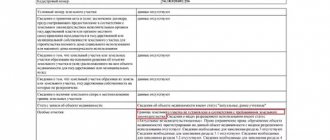The assessment of a land plot in terms of its market value and the possibility of sale on the terms chosen by the owner is important for the owner for several reasons. Even if you do not intend to alienate this property in any way, it is necessary to have information about its liquidity, real value, the ability to take it into account when dividing property or a general assessment of your own solvency.
Each of these and many other options requires a specific methodological approach to achieving results. In addition, the real cadastral value of land directly affects the amount of taxes that will be charged on real estate. And this criterion is closely related to the market value of the site. Valuation of real estate, taking into account its properties and prospects for changes in liquidity, is a type of examination that takes into account a large number of interrelated factors.
State Budgetary Institution – powers of state cadastral valuation institutions in 2021
So, from January 1, 2021, cadastral valuation of real estate is carried out in accordance with the provisions of the law of July 3, 2016 N 237-FZ (as amended on July 29, 2017) “On State Cadastral Valuation.” It wasn't always like this. Previously, the cadastral value was determined by third-party organizations on a competitive basis. Municipalities made a decision to conduct a state cadastral assessment, and then selected the work performers with whom they entered into a contract. This was provided for by the Law of July 29, 1998 N 135-FZ “On Valuation Activities in Russia”, which is still in force today, with the exception of a number of suspended articles.
What powers does the State Budgetary Institution have for cadastral valuation?
From January 1, 2021, the cadastral value is determined only by government organizations (GBU). The state budgetary institution for determining the cadastral value is created on the basis of an order or instruction from an authorized body of a constituent entity of the Russian Federation.
Thus, in each subject of Russia there is a government structure whose main functions and powers are:
- assessment of the cadastral value of real estate according to Law 237-F3 (in accordance with Article 14);
- determination of the cadastral value of newly created and registered objects;
- cadastral valuation of changed real estate objects (during an extension or demolition of part of a house, changing the area, etc.);
- collecting materials, processing data, as well as recording them on storage devices and storing information used during the cadastral valuation;
- providing Rosreestr with information obtained as a result of its activities.
Methods of examination and assessment of land
The customer of an independent assessment and examination is interested in what criteria are taken into account by the experts, how objective the result in the conclusion is, whether it is possible to pose questions in such a way as to “direct” the course of the analysis in the direction that interests you.
The specialist has several analysis techniques at his disposal, thanks to which the data collected during the study of documents and inspection of the territory can be used to obtain a clear picture of the cost and value of the property, taking into account its prospects. There is no one, universal method; the objective result is formed in a complex manner. The most complete results that are not related to the expert’s personal opinion are obtained by a combination of information analysis methods.
Land value from different points of view
The concept of value when assessing real estate can be interpreted from several points of view:
- market - this is an idea of the most likely price at which a plot of land can be sold, taking into account the competitive environment and real conditions in the area at the time of valuation;
- investment - this is the idea of the value of property that must be contributed as a share or investment in business use;
- liquidation is an idea of the amount that can be received by quickly selling property, without waiting for the most favorable offers and without taking into account likely competition;
- cadastral - to establish the tax base, the basis for calculating the amount of taxes, which is especially important if owners are looking for justification for reducing this base.
As a result, you can get a result that reflects any of the above points of view and use the result as an argument in disputes, when allocating shares or in court, when dividing property.
Factors influencing the price of land
The factors that are taken into account when assessing real estate and the value of land are varied. They are combined into groups, and during the analysis they are taken into account with varying degrees of probability of their impact on the final result. Without going into the intricacies of the methodology, we can say that the expert takes into account:
- the location of the site, the nature of its interaction with the environment, the features of the area and relief, the general level of development of the settlement, the purpose of the land;
- the cost of plots located in the area;
- the potential level of investment when it comes to the use of land, the likelihood of receiving income and their relationship to costs;
- the presence of buildings that facilitate or hinder the full use of the land, requiring demolition or restoration;
- the competitiveness of the object in comparison with analogues, factors that can have an increasing or decreasing impact on the cost, dynamics of development of the territory, the presence of communications, “red lines” that limit the possibilities of development or use of land.
This is a brief listing that reflects only the main areas of data collection for analysis. Documents that reflect ownership are studied, since its exclusivity or division into several persons seriously affects the final price of the object.
Quality and objectivity of assessment
Can the expert appraiser’s conclusions be considered objective and reflect the true state of affairs? Is the specialist responsible for the results, is the conclusion suitable for going to court, making claims, settling disputes?
The objectivity of the conclusions comes from careful data collection. The more information provided for analysis, the less dependent the result is on the expert’s personal opinion. To more accurately determine the value of a plot of land, the assessment is carried out using correction factors. This takes into account the difference in real estate values, for example, between the Moscow region and the Tula region - for the Moscow region the territorial coefficient is higher, it reflects the general price level in the region.
Expert's responsibility
Responsibility for the result of the assessment is part of the contract, which is concluded before the provision of the service. If there is a significant discrepancy between the indicated amounts and the real market picture, the customer may insist on revising the conclusion and conducting a repeat study. But it should be taken into account that the market price of land is not a constant value. It changes over time, and these fluctuations are usually reflected in the estimate - the result is presented as the boundaries of the range of the most likely values.
Requirements for State Budgetary Institution specialists carrying out cadastral valuation of real estate
GBU employees who determine the cadastral value must meet the following qualification requirements :
- have a higher education in one of the fields: management, economics, mathematics, computer science, geoscience, biology, architecture, technology, applied geology, geodesy, mining, oil and gas, business, agriculture, forestry and fisheries;
- be unconvicted citizens of the Russian Federation;
- have experience in the field of determining cadastral value (from 3 years) - for those who sign the cadastral value report.
Requirements for employees of the State Budgetary Institution for cadastral valuation are prescribed at the federal level in Law 237-FZ, as well as in Order of the Ministry of Economic Development dated July 12, 2017 No. 177.
Distribution method
The method is used to evaluate built-up land plots.
Conditions for using the method:
availability of information on the prices of transactions with single real estate objects, similar to a single real estate object, which includes the land plot being assessed. In the absence of information on transaction prices, it is permissible to use supply (demand) prices; availability of information on the most probable share of a land plot in the market value of a single property; correspondence of land improvements to its most effective use.
The method involves the following sequence of actions:
determination of the elements by which a single real estate object, including the assessed land plot, is compared with analogous objects; determination for each of the elements of comparison of the nature and degree of differences of each analogue from a single real estate object, including the assessed land plot; determination for each of the comparison elements of price adjustments of analogues, corresponding to the nature and degree of differences of each analogue from a single real estate object, including the land plot being assessed; adjustment for each of the elements of price comparison for each analogue, smoothing out their differences from a single real estate object, which includes the land plot being assessed; calculation of the market value of a single property, including the assessed land plot, by means of a reasonable generalization of the adjusted prices of analogues; calculation of the market value of the assessed land plot by multiplying the market value of a single real estate object, which includes the assessed land plot, by the most probable value of the share of the land plot in the market value of a single real estate object.
Center for State Cadastral Valuation
GBU for determining cadastral value is often called the center of state cadastral valuation.
Indeed, on the territory of a subject of the Russian Federation, be it a region, a republic, a district or a region, there is one institution that determines the cadastral value - this is a kind of central apparatus operating in a certain territory. In each subject, these institutions have their own numbers, staffing, additional functions and powers, and also have an individual name.
For example, in the Leningrad region - State Budgetary Institution "LenKadOtsenka", In Crimea - State Budgetary Institution "Land Management [/anchor] and Cadastral Valuation", in Mordovia - State Budgetary Institution "Property Fund" but most often, for example, in Altai, Buryatia, Yakutia, Amur , Belgorod and other regions, the state-authorized institution for determining cadastral value is called the Center for State Cadastral Valuation.
Cadastral Valuation Data Fund
The Federal Cadastre and Cartography Service (Rosreestr) on its official website https://rosreestr.ru/ contains information on the assessment of cadastral value. This section of information is called “Cadastral Valuation Data Fund”. Here you can enter the cadastral number of your property (land plot, house) of interest and find out what the cadastral value of the property is, the date of the assessment, information about the results of the cadastral assessment.
In addition, you can find out when and where valuation activities are planned, as well as find out other information of interest about the cadastral valuation and the possibilities of challenging it. But not all information in the Cadastral Valuation Data Fund is freely available - some is hidden and accessible only to Rosreestr employees.
The value of land as real estate
The need to assess the value of a plot of land and the buildings located on it arises in different situations. The owned territory has several important properties that other objects of material ownership do not have.
- The earth does not have a wear and tear resource; such concepts as depreciation or loss of functionality do not apply to it.
- Land cannot be considered as a reproducible resource for the owner - it cannot be renewed, or radically change its quality characteristics, even if environmental conditions change.
- Land cannot multiply, the number of plots can be considered constant, and this indicates the stability of demand, which from the market point of view is always a sign of a future increase in price.
- From a practical point of view, the owner of the plot not only controls part of the land surface, he has the opportunity to use its properties, for example, location or exploitation. Even when divided into shares, the land retains high value for the owners.
What does this mean for the owner? At a minimum, owning property, the value of which will only grow in the future. And under certain circumstances, knowledge of market valuation becomes a real necessity.









